Clay storage jars offer a natural way to keep your spices fresh and flavorful. The porous clay walls create an ideal environment by regulating moisture and temperature while preventing mold growth. You'll want to choose high-quality jars with airtight lids and store them in a cool, dry place away from direct heat. Clean and dry your jars thoroughly before use, and label them clearly for easy identification. The clay's unique properties can absorb up to 30% of its weight in moisture, maintaining excellent humidity levels for your spices. Discover how these time-tested containers can transform your spice storage and preservation routine.
Benefits of Clay Storage Containers
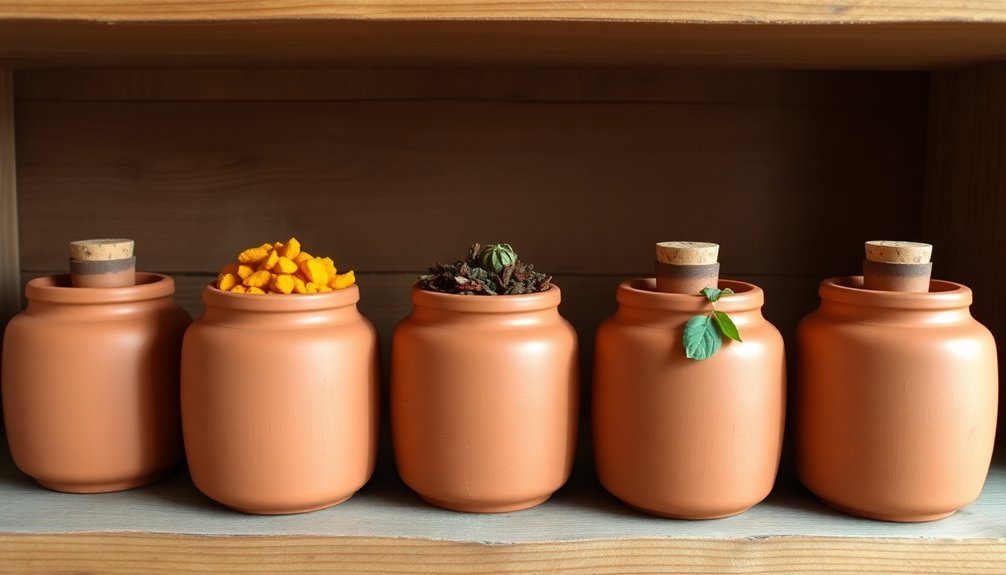
With their time-tested durability and natural composition, clay storage containers offer a superior solution for keeping your spices fresh. They're handcrafted by skilled artisans and fired at high temperatures, ensuring you'll get a sturdy product that won't crack easily under normal kitchen conditions. When you care for them properly, these containers can serve you for many years. Like glass jars, clay containers allow you to easily monitor your spice levels.
You'll find that clay containers aren't just functional – they're beautiful additions to your kitchen space. Each handmade piece is unique, making them perfect as decorative elements or thoughtful gifts for special occasions. Their elegant appearance enhances any room where you place them.
If you're environmentally conscious, you'll appreciate that clay containers are made from natural, organic materials. They're a sustainable alternative to plastic, reducing landfill waste while promoting eco-friendly living.
The non-porous nature of clay helps maintain your spices' freshness by creating a stable internal environment and protecting against moisture and humidity. You won't have to worry about harmful substances leaching into your spices, and cleaning these containers is straightforward.
They're versatile enough to store in various kitchen locations while maintaining the quality of your spices.
Choosing the Right Clay Jars
Selecting the right clay jars for your spices requires careful attention to several key features. When choosing clay containers, you'll want to verify they're made from high-quality, non-reactive materials with food-safe glazing to protect your spices from contamination and maintain their freshness. Traditional ceramic materials have proven ideal for preventing flavor deterioration while storing spices.
Reflect on the size of your jars based on your spice usage patterns. For frequently used spices, opt for smaller 2-4 oz containers, while less common ingredients can go in 6 oz jars. You'll want to match these sizes to your available kitchen storage space while confirming you're not storing more than you'll use in a reasonable time.
The sealing mechanism is essential for preserving your spices. Look for jars with reliable airtight lids, whether they're screw-on, cork, or wooden varieties. Check for any gaps or defects in the sealing system that could compromise freshness.
You'll also want to evaluate practical features like easy-to-clean surfaces and clear labeling options. If possible, choose jars that are dishwasher safe and either transparent or semi-transparent, making it simple to identify contents without opening. Stackable designs can help maximize your storage space while keeping spices accessible.
Preparing Jars for First Use
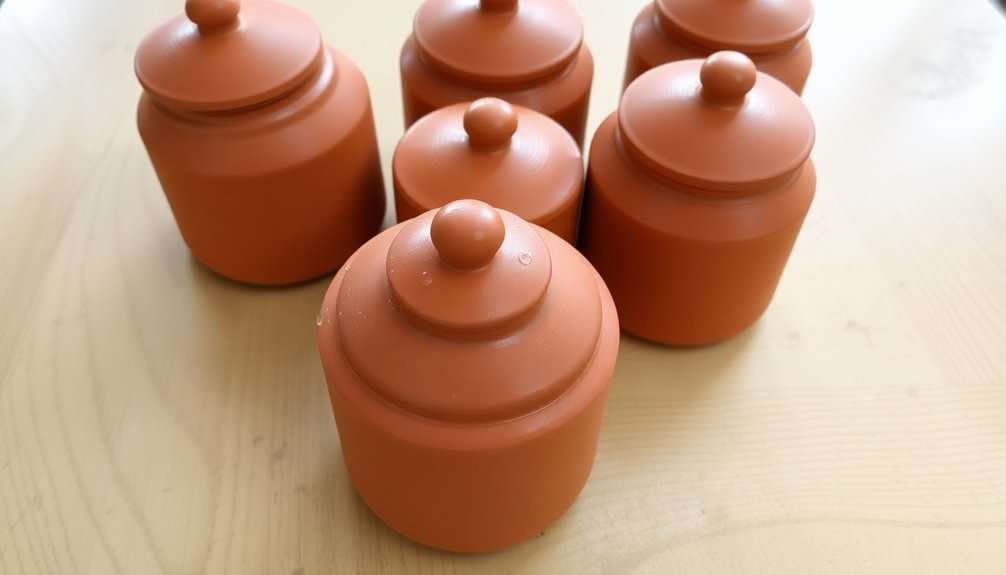
Once you've selected the perfect clay jars for your spices, proper preparation guarantees they'll serve you well for years to come. Before using your new clay containers, you'll need to confirm they're thoroughly cleaned and properly conditioned.
Start by examining your jars for any glazes or coatings that might interfere with the clay's natural properties. Ensure each jar is cleaned by hand or in the dishwasher for optimal results. If you've made the jars yourself, confirm they've dried completely at room temperature for at least 24 hours before proceeding to the firing stage.
Place your clay containers on a cookie sheet and begin the firing process at 150-180°F for 1-2 hours to remove any remaining moisture. Gradually increase your oven's temperature to just above water's boiling point, then up to 350°F over two hours. If you prefer, you can fire the jars in a charcoal BBQ, layering them between charcoal.
Once fired, let the containers cool completely before handling them. Before storing your spices, verify that your jars are completely dry and cooled. Position them away from direct sunlight and heat sources, and don't forget to label each container clearly for easy identification.
Your properly prepared clay jars will help maintain your spices' freshness and flavor.
Essential Clay Jar Features
Clay storage jars have naturally porous walls that let your spices breathe while still maintaining freshness through their airtight lids.
You'll find these pores work alongside the jar's moisture control properties to prevent clumping and maintain ideal humidity levels for your spices.
The clay material also regulates temperature naturally, protecting your spices from sudden heat changes that could affect their quality.
Breathable Porous Clay Walls
Three key aspects define the breathable nature of clay jar walls: their inherent porosity, heat resistance, and protective qualities.
The porous structure of clay allows your spices to breathe naturally, maintaining their freshness through controlled air exchange. This unique characteristic helps prevent moisture buildup while preserving the essential oils that give your spices their distinct flavors and aromas.
You'll find that clay's natural heat resistance works to your advantage. Unlike metal or glass containers that can conduct temperature changes, clay maintains a relatively stable environment for your spices. This insulating property protects your seasonings from temperature fluctuations that could degrade their quality.
While the porous nature of clay offers benefits, you'll need to take into account some practical aspects. Store your clay jars in a cool, dry place away from direct sunlight to maximize their protective qualities.
Since clay can react with certain spices, you might want to monitor your stored seasonings initially to verify compatibility. The breathable walls will help maintain freshness, but you'll still need to check periodically for any unwanted moisture absorption.
Remember to clean your jars regularly to prevent flavor transfer and maintain ideal storage conditions.
Moisture Control Properties
Managing moisture levels effectively stands as an essential feature of clay storage jars for spices. You'll find that clay desiccants can absorb up to 30% of their weight in moisture, making them exceptional at controlling humidity in your spice storage. This remarkable absorption capacity works continuously to prevent mold and mildew growth, which can quickly ruin your precious spices.
When you store your spices in clay jars, you're creating a stable environment that maintains ideal humidity levels. The clay's natural ability to regulate moisture helps preserve the flavor, aroma, and texture of your spices over extended periods. You won't have to worry about moisture-related spoilage or degradation, especially if you live in a humid climate.
To maximize these moisture control benefits, you'll want to place your clay storage jars in a cool, dry area away from direct sunlight and heat sources. Don't keep them near your stove or in humid spaces like bathrooms.
Remember to use airtight lids and maintain good ventilation in your storage area. By following these practices, you'll guarantee your spices stay fresh and flavorful for longer periods.
Natural Temperature Regulation
Beyond their moisture-wicking abilities, clay storage jars offer outstanding temperature regulation for your spices. Their natural insulating properties help maintain temperatures between the ideal 50°F to 70°F range, protecting your spices from the heat that can break down essential oils. You'll find that clay jars act as natural buffers against temperature fluctuations, especially when you store them away from heat sources like stoves and microwaves.
| Feature | Benefit | Impact |
|---|---|---|
| Thermal Mass | Maintains Stable Temperature | Preserves Essential Oils |
| Natural Insulation | Buffers External Heat | Extends Shelf Life |
| Porous Structure | Regulates Internal Climate | Maintains Potency |
The natural temperature regulation of clay jars works alongside their light-blocking properties to create an excellent storage environment. You'll want to place your clay spice jars in a dedicated cabinet or pantry where they're protected from direct sunlight and heat sources. When you combine clay's temperature-regulating abilities with proper organization and labeling, you'll create an efficient system that keeps your spices fresh and potent for longer periods. The consistent internal environment that clay provides helps preserve the volatile compounds responsible for your spices' distinctive flavors and aromas.
Humidity Control With Clay Vessels
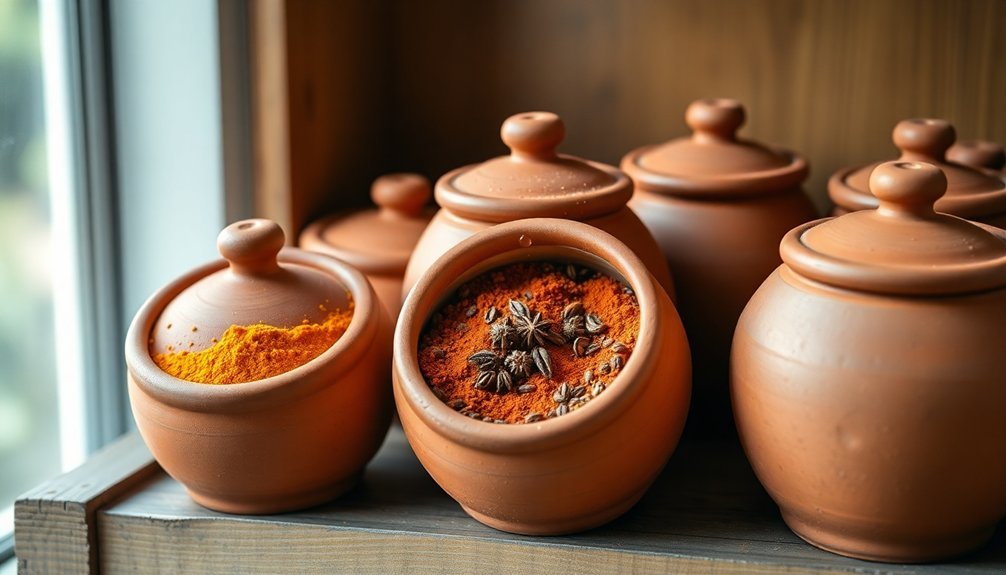
Clay vessels' natural ability to absorb and release moisture makes them perfect for keeping your spices at ideal humidity levels.
You'll notice how the porous structure acts like a microscopic sponge, pulling in excess moisture when humidity is high and releasing it back when conditions become too dry.
Your spices benefit from this self-regulating effect, as the clay maintains steady temperature and humidity conditions that help preserve their freshness longer.
Natural Moisture Absorption Properties
The natural porosity of clay vessels presents both advantages and challenges for spice storage. While clay can absorb and release moisture, you can't rely on this process alone to protect your spices. The uncontrolled moisture exchange through the vessel's walls can actually expose your valuable spices to unwanted humidity fluctuations, potentially compromising their quality.
You'll need to take additional steps if you're planning to use clay containers for your spices. First, ascertain you're using proper sealing methods since clay vessels aren't naturally airtight. Consider adding humidity control packs inside your containers to maintain ideal moisture levels.
You'll also want to protect against light exposure, as clay vessels typically don't offer adequate protection from oxidation-causing light. If you're committed to using clay storage, you'll need to combine it with modern humidity control measures.
Store your sealed clay containers in a cool, dry area away from heat sources and steam. Don't use wet utensils when handling spices, and avoid sprinkling them directly into steaming pots. Regular monitoring of your spices' condition will help you catch any moisture-related issues early.
Clay Porosity Benefits
Through microscopic pores, clay vessels offer a sophisticated humidity control system for your spices. When clay particles fuse during the firing process, they create a natural network of tiny openings that actively regulate moisture levels.
You'll find that these pores work continuously to absorb excess humidity when it's too high and release moisture when conditions become too dry.
This natural porosity brings several key benefits to your spice storage:
- Prevents your spices from clumping or hardening by maintaining ideal moisture levels
- Protects essential oils and volatile compounds that give spices their distinct flavors
- Reduces the risk of mold growth by keeping humidity balanced
- Minimizes oxidation damage by controlling moisture exposure
You can enhance these benefits by choosing the right clay container setup.
Whether you're using riverbank clay or other natural varieties, the porous structure remains effective. The versatility of clay means you can select containers that match your storage needs, from small spice jars to larger vessels.
While the clay works its magic, remember to keep your spices in a cool, dark place to maximize their shelf life and preserve their aromatic qualities.
Temperature Regulation Effects
Inside your clay storage vessels, three powerful mechanisms work together to maintain ideal temperature and humidity conditions for your spices. The bentonite clay actively adsorbs excess moisture from the air, creating a protective barrier against humidity fluctuations. You'll find this particularly beneficial in preventing clumping and preserving your spices' aromatic compounds.
| Temperature Factor | Clay Response | Benefit |
|---|---|---|
| Heat Exposure | Thermal Buffering | Maintains 50-70°F Range |
| Humidity Levels | Moisture Adsorption | Prevents Clumping |
| Environmental Changes | Slow Release System | Stabilizes Contents |
To maximize these benefits, you'll want to place your clay storage jars in a cool, dark cabinet away from heat sources like stoves and microwaves. The porous nature of bisque-fired clay disks helps regulate internal conditions by releasing or absorbing moisture as needed. They're especially effective when you store smaller quantities of spices rather than bulk amounts.
For best results, keep your clay storage system sealed when not in use, and avoid placing it near sinks or other moisture-prone areas. The clay's natural ability to maintain consistent conditions means you won't need artificial desiccants, making it an efficient, reusable solution for long-term spice storage.
Proper Cleaning and Maintenance
Maintaining your clay spice jars' cleanliness requires specific care to preserve their natural properties. Instead of using harsh detergents that can seep into the clay, opt for natural cleaning solutions like salt and baking soda to scrub away residue and eliminate unwanted odors.
You'll need to guarantee thorough drying after each cleaning to prevent mold growth and maintain the jars' integrity.
To effectively clean and maintain your clay spice jars, follow these essential steps:
- Scrub the jars with a mixture of salt and baking soda, then rinse with mild dish soap, ensuring no soap residue remains.
- Dry the jars completely under sunlight or on medium heat, using a clean towel for both interior and exterior surfaces.
- For stubborn odors, boil water with baking soda and lemon slices inside the jar.
- Allow proper ventilation during storage by avoiding closed cabinets and stacking jars with space between them.
Remember not to shock your clay jars with extreme temperature changes, as this can cause cracking.
Regular inspection for damage and proper seasoning of new jars will help extend their lifespan and maintain their effectiveness in storing your spices.
Temperature Regulation Through Clay
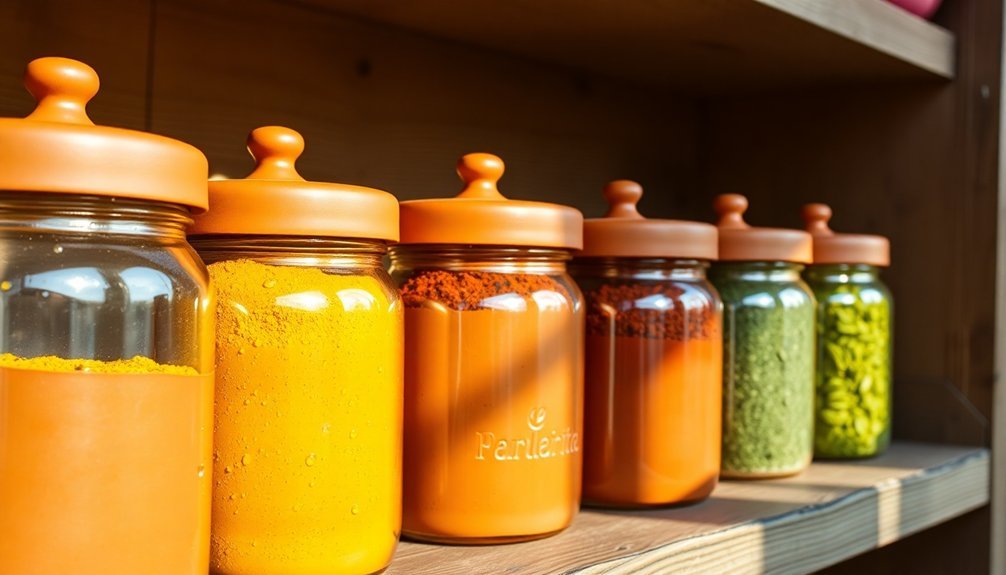
Clay's natural cooling properties make it an excellent material for keeping your spices at a stable temperature through its thermal mass and moisture-wicking abilities.
You'll find that clay storage containers help maintain an ideal environment by naturally absorbing excess moisture when humidity rises and releasing it when conditions become too dry.
These temperature-regulating qualities work alongside clay's porous structure to protect your spices from harmful temperature fluctuations that can degrade their flavors and aromas.
Natural Cooling Properties
Three remarkable properties make clay storage jars ideal for keeping spices fresh: porosity, evaporative cooling, and natural temperature regulation.
When you store your spices in clay jars, you'll benefit from their natural ability to maintain cooler temperatures through evaporation, even in hot climates.
Clay's cooling mechanism works through water evaporation from its porous surface, which can reduce temperatures by up to 8.3°C.
You'll find this process particularly effective in low-humidity environments, where the evaporative cooling reaches its maximum potential.
For best results with your clay spice storage, follow these essential steps:
- Place your clay jars on concrete surfaces rather than sandy ones for faster cooling
- Keep the jars away from direct sunlight and heat sources
- Consider using a damp cloth over the top to enhance the cooling effect
- Maintain regular care by ensuring proper ventilation
The cooling efficacy of clay containers isn't just theoretical – studies show they can achieve temperature reductions of 20.5% to 71.3% of the maximum possible evaporative cooling.
You'll notice your spices stay fresher longer when stored at these consistently cool temperatures, which typically remain close to standard room temperature (20-25°C).
Moisture Balance Benefits
A balanced moisture environment stands at the heart of clay storage's effectiveness for spices. When you store your spices in clay containers, you'll benefit from their natural ability to regulate humidity through a sophisticated absorption and release mechanism.
The porous structure of bisque-fired clay works like a rigid sponge, maintaining consistent moisture levels that protect your spices' essential oils and flavors.
You'll find that clay storage prevents two common problems that plague spice storage: excess moisture that leads to clumping and over-drying that diminishes flavor. The clay's evaporative process creates an ideal environment where your spices won't degrade or lose their potency.
Unlike plastic or glass containers, clay vessels actively respond to environmental changes, slowly releasing or absorbing moisture as needed.
The practical benefits extend beyond just moisture control. You won't need to worry about mold growth since clay doesn't provide nutrients for fungi. Your spices will maintain their freshness longer, and you can even revive slightly dried-out spices through the clay's gentle rehydration properties.
Best of all, clay storage is chemical-free and safe for all your organic spices.
Thermal Mass Advantages
Throughout the day and night, your clay spice jars work silently as temperature regulators, thanks to their impressive thermal mass properties. When temperatures rise during the day, the clay absorbs excess heat, preventing your spices from experiencing sudden temperature spikes.
As evening approaches, the stored heat gradually releases, maintaining a stable environment for your valuable seasonings.
This natural temperature regulation system offers several key advantages for preserving your spices:
- Clay's high thermal mass can reduce temperature fluctuations by up to 10°C below ambient temperature, keeping your spices in prime condition.
- You'll save energy since there's no need for artificial cooling methods to maintain consistent temperatures.
- The natural cooling effect works continuously, protecting your spices from heat damage 24/7.
- Your spices stay fresher longer due to the stable environment created by clay's thermal properties.
To maximize these benefits, place your clay storage jars in a shaded, well-ventilated area. This positioning enhances the natural cooling properties of the clay and guarantees your spices remain at their best quality for extended periods.
Spice Organization in Clay Containers
Organizing spices in clay containers sets up an elegant, eco-friendly storage system that enhances both functionality and kitchen aesthetics.
You'll find these natural containers offer unique benefits, from their porous nature that maintains spice freshness to their alkaline properties that help neutralize acidity in your seasonings.
You can arrange your clay containers in various ways to suit your kitchen space. Whether you're storing them in drawers with specialized liners or displaying them on open shelves, they'll add a decorative touch while keeping your spices accessible.
The containers come in different sizes, so you'll easily accommodate both frequently used spices and specialty blends.
To maintain your clay spice storage system, you'll want to keep the containers away from direct sunlight and excessive moisture. They're easy to clean, and their high-temperature treatment guarantees they'll last for years with proper care.
The containers' natural composition means they'll release beneficial minerals like iron and calcium, enriching your spices while storing them.
You're not just organizing your kitchen; you're choosing a sustainable option that reduces plastic waste and maintains the quality of your spices naturally.
Traditional Clay Storage Methods
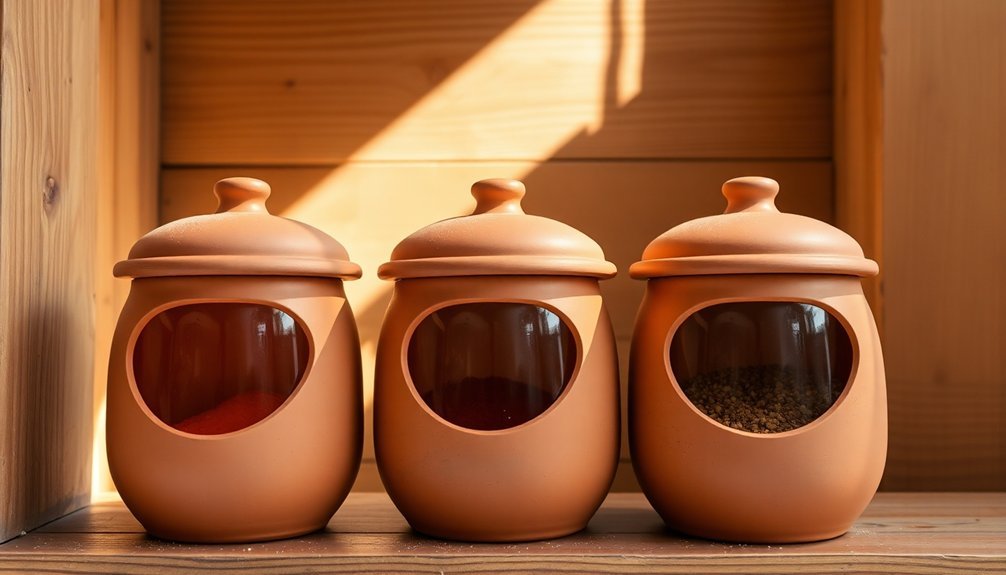
Traditional clay storage methods reach back into ancient civilizations, where cultures from India to Egypt relied on these natural containers to preserve their precious spices.
You'll find that these time-tested techniques weren't just practical – they were deeply woven into cultural and spiritual traditions, particularly in regions like Tamil Nadu, where Kalchattis served both functional and sacred purposes.
The beauty of traditional clay storage lies in its natural properties that protect your spices. When you're storing spices in clay containers, you'll benefit from the material's unique ability to regulate moisture while keeping flavors intact.
For the best results using traditional clay storage methods, follow these time-honored practices:
- Place your clay containers in cool, shaded areas to maintain consistent temperatures
- Stack containers efficiently to maximize kitchen space while ensuring easy access
- Keep spices protected from direct sunlight to prevent quality degradation
- Use airtight clay containers for moisture-sensitive spices like saffron and cloves
You'll find that these traditional methods still work remarkably well today, offering natural preservation without modern additives or synthetic materials.
Extending Spice Life With Clay
Modern research actually contradicts long-held beliefs about clay's effectiveness for spice storage. You'll want to avoid clay containers entirely due to their porous nature, which can expose your spices to moisture and compromise their freshness.
Instead, you should opt for airtight containers made of glass, ceramic, tin, or BPA-free plastics.
To maximize your spices' shelf life, you'll need to focus on proper storage conditions. Keep them in a cool, dark place away from your stove, refrigerator, and any heat sources.
Don't store spices in areas with fluctuating temperatures, as this can greatly reduce their potency. Remember that whole spices can last 2-4 years, while ground spices typically maintain their flavor for only 6-10 months.
You'll get the best results by organizing your spices in clear, appropriately-sized containers that minimize air space. Label each container with the name and purchase date, and consider grouping them by cuisine or common use.
For spices that lose potency quickly, like turmeric and black pepper, use opaque containers and replace them more frequently to maintain their flavor and effectiveness.
Frequently Asked Questions
Can Clay Jars Be Used to Store Liquid Spice Pastes?
You shouldn't store liquid spice pastes in clay jars, as they're porous and can cause seepage, contamination, and flavor changes. Instead, use airtight containers made of glass, stainless steel, or food-safe plastic.
What Paint or Decoration Is Safe to Use on Clay Spice Jars?
You'll want to use non-toxic, food-safe paints like mineral-based or ceramic glazes. Chalk markers work great for labeling, and you can apply natural beeswax or food-grade sealants for protection and decoration.
How Do Clay Jars Compare to Bamboo Containers for Spice Storage?
While you'll find both options effective, clay jars offer better temperature control and natural preservation, but bamboo containers are lighter and less breakable. Each has unique benefits for storing your spices.
Will Clay Jars Affect the Taste of Highly Acidic Spice Blends?
Yes, your acidic spice blends may experience flavor changes in clay jars. They'll react with the clay material, even if properly seasoned. You're better off choosing non-reactive containers like glass for these blends.
Are Antique Clay Spice Jars Safe for Modern Spice Storage?
You shouldn't use antique clay jars for storing spices, as they may contain harmful materials or have structural damage. Instead, opt for new, food-grade clay containers that meet modern safety standards.
In Summary
You'll find clay storage jars to be invaluable allies in preserving your spices' potency and flavor. Their natural ability to regulate humidity and temperature while allowing minimal air exchange creates an ideal environment for your precious seasonings. Make the switch to clay containers, and you'll notice your spices staying fresher longer, maintaining their aroma, and delivering better results in your cooking.
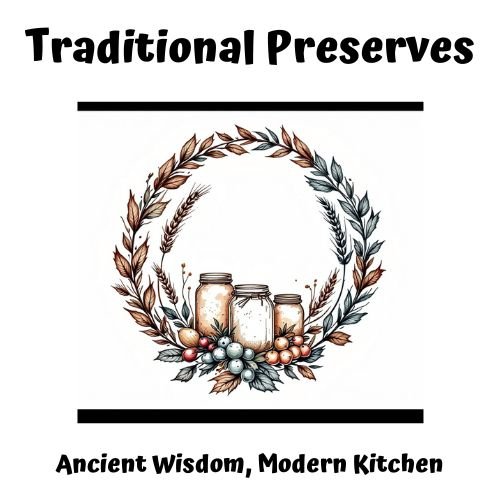
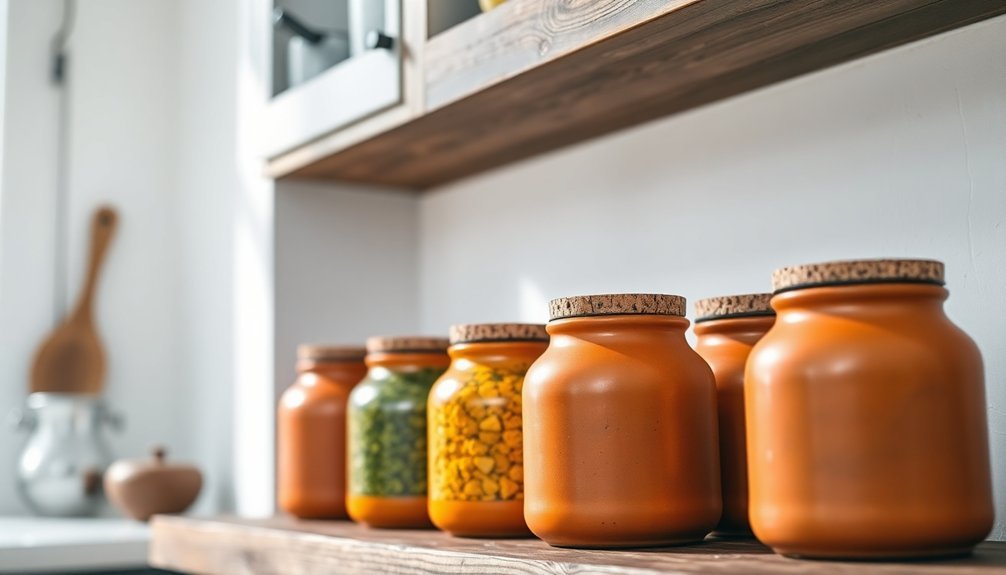
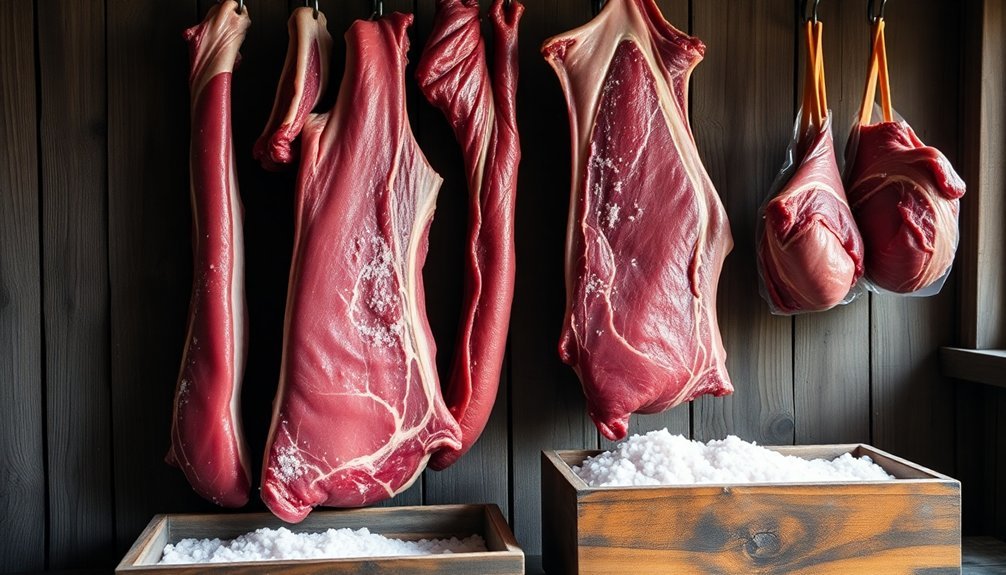
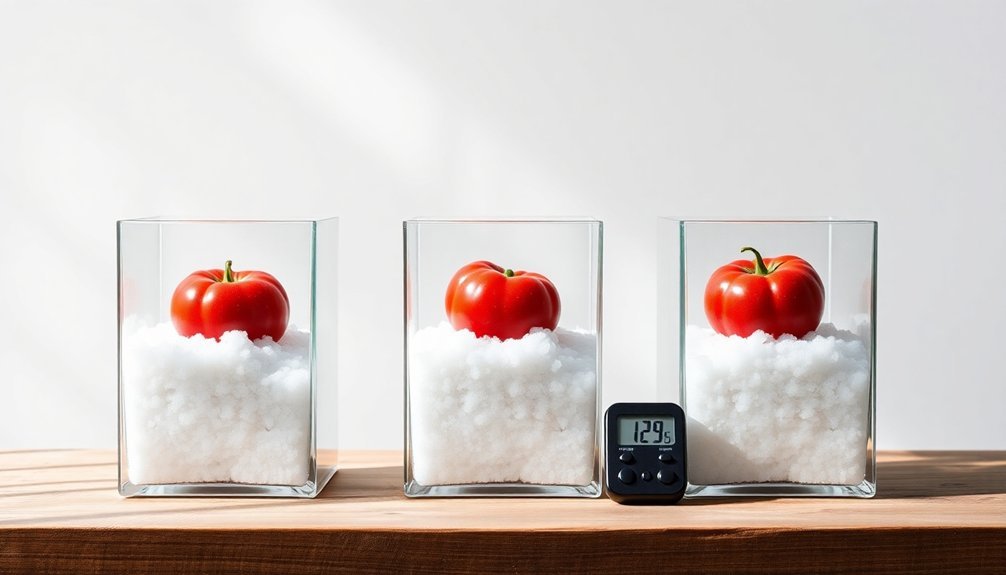
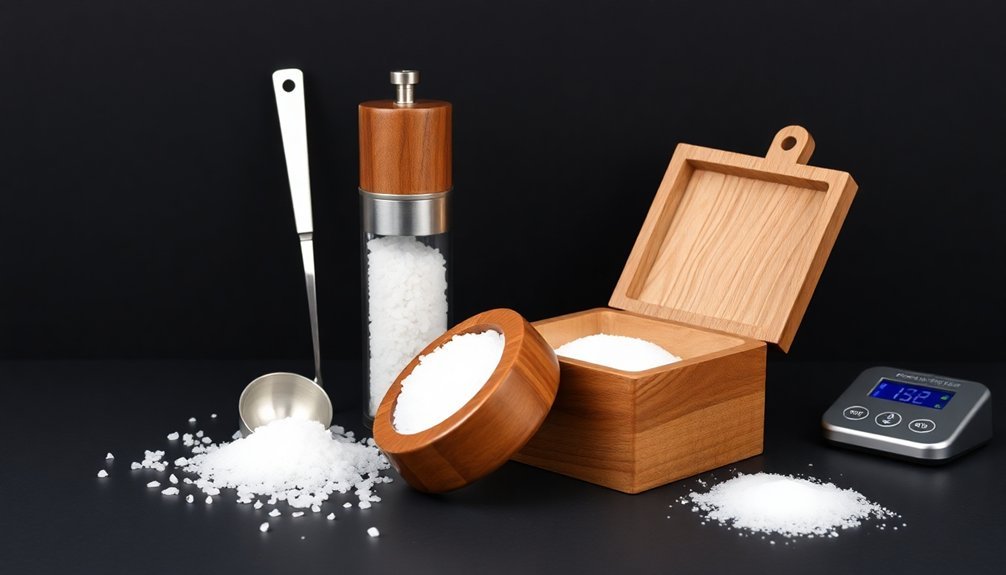
Leave a Reply